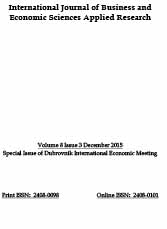Four currencies outside the eurozone
Four currencies outside the eurozone
Author(s): Imre Vámos, Zsuzsanna NovákSubject(s): Economy
Published by: Τεχνολογικό Εκπαιδευτικό Ίδρυμα Ανατολικής Μακεδονίας και Θράκης
Keywords: exchange estimates; public debt; cointegration
Summary/Abstract: Purpose - In the European Union only a few countries have remained outside the eurozone. Among these countries with independent monetary policies few pursue a floating exchange rate regime: the Czech Republic, Hungary, Poland and Romania (IMF, 2013). The purpose of the paper is to examine whether there is a cointegrating relationship between the same underlying economic fundamentals and the realand nominal exchange rate of these countries against the euro. Design/methodology/approach – The quarterly data used for analysis for the period between 2000 and 2014 were provided by the Eurostat and European economy databases. After testing for unit root in the logarithmised data series Engel-Granger and Johansen tests are applied to discover the existence of longrun equilibrium relationships between the exchange rates and fundamentals explaining balance of payments equilibrium. Findings –Based on a uniform behavioural exchange rate model cointegration can only be revealed in the case of the Polish nominal exchange rate data, though simple OLS estimations indicate a strong relationship between fundamentals and exchange rates in the case of all the four countries. Research limitations/implications – The paper points out that it is difficult to prove the existence of any such relationship: making forecasts of the paths of equilibrium exchange rates is hampered by the lack of an adequate model, the short time series and the strong volatility of these currencies, especially the Hungarian forint and the Romanian leu. Another reason for the low explanatory value of various models can be frequent central bank intervention. Originality/value – As Dick et al. (2015) reveals good exchange rate estimates rely on the forecasters ability to understand the relation between fundamentals and the exchange rates mostly in times when exchange rate more strongly deviate from their PPP value. Therefore, applying more approaches for exchange rate analysis helps us better observe this relationship.
Journal: International Journal of Business and Economic Sciences Applied Research (IJBESAR)
- Issue Year: VIII/2015
- Issue No: 3
- Page Range: 97-108
- Page Count: 12
- Language: English

